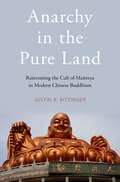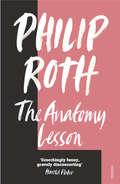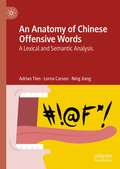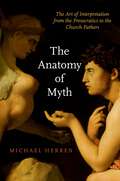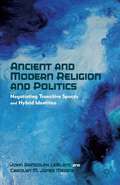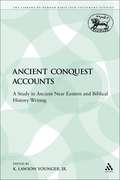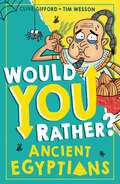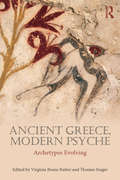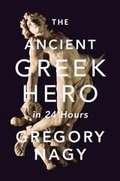- Table View
- List View
Anarchy in the Pure Land: Reinventing the Cult of Maitreya in Modern Chinese Buddhism
by Justin RitzingerAnarchy in the Pure Land investigates the twentieth-century reinvention of the cult of Maitreya, the future Buddha, conceived by the reformer Taixu and promoted by the Chinese Buddhist reform movement. The cult presents an apparent anomaly: It shows precisely the kind of concern for ritual, supernatural beings, and the afterlife that the reformers supposedly rejected in the name of "modernity." This book shows that, rather than a concession to tradition, the reimagining of ideas and practices associated with Maitreya was an important site for formulating a Buddhist vision of modernity. Justin Ritzinger argues that the cult of Maitreya represents an attempt to articulate a new constellation of values, integrating novel understandings of the good, clustered around modern visions of utopia, with the central Buddhist goal of Buddhahood. In Part One he traces the roots of this constellation to Taixu's youthful career as an anarchist. Part Two examines its articulation in the Maitreya School's theology and its social development from its inception to World War II. Part Three looks at its subsequent decline and contemporary legacy within and beyond orthodox Buddhism. Through these investigations, Anarchy in the Pure Land develops a new framework for alternative understandings of modernity in Buddhism.
The Anatomy Lesson: The Ghost Writer; Zuckerman Unbound; The Anatomy Lesson; The Prague Orgy (The\nathan Zuckerman Ser. #3)
by Philip Roth'The Anatomy Lesson is a ferocious, heartfelt book - lavish with laughs and flamboyant inventions' John UpdikeWith his fortieth birthday receding into the distance, along with his hairline and his most successful novel, the writer Nathan Zuckerman comes down with a mysterious affliction – pure pain, beginning in his neck and shoulders, invading his torso, and taking possession of his spirit. Zuckerman, whose work was his life, finds himself physically unable to write a line. He treks from one doctor to another, but none can find a cause for the pain and nobody can assuage it. Could it be, he wonders to himself, that the cause of the pain is nothing less than the books he has written?As he grapples with this possibility, he tries an onslaught of painkillers, then vodka, and finally marijuana. He contemplates threatening the pain with suicide, attempting to scare it out of his system. He toys with the prospect of a dramatic career change. What will it take for the pain to finally leave him alone?
An Anatomy of Chinese Offensive Words: A Lexical and Semantic Analysis
by Lorna Carson Ning Jiang Adrian TienThis book offers a precise and rigorous analysis of the meanings of offensive words in Chinese. Adopting a semantic and cultural approach, the authors demonstrate how offensive words can and should be systematically researched, documented and accounted for as a valid aspect of any language. The book will be of interest to academics, practitioners and students of sociolinguistics, language and culture, linguistic taboo, Chinese studies and Chinese linguistics.
Anatomy of Dissent in Islamic Societies: Ibadism, Rebellion, and Legitimacy
by A. SouaiaiaAnatomy of Dissent in Islam is an interdisciplinary study of political and legal dissent in Islamic civilization from the seventh century on. (7th century). Using Ibadism as a case study, this work explores the events and teachings that shaped legitimacy and rebellion, orthodoxy and sectarianism, and law and culture in Islamic societies.
The Anatomy of Myth: The Art of Interpretation from the Presocratics to the Church Fathers
by Michael HerrenThe Anatomy of Myth is a comprehensive study of the different methods of interpreting myths developed by the Greeks, adopted by the Romans, and eventually passed on to Jewish and Christian interpreters of the Bible. Greek thinkers only rarely saw "myth" as a category of thought in its own right. Most often they viewed myths as the creation of poets, or else as an ancient revelation that had been corrupted by them. In the first instance, critics attempted to find in the intention of the authors some deeper truth, whether physical or spiritual; in the second, they deemed it necessary to clear away poetic falsehoods in order to recapture an ancient revelation. Parallel to the philosophical critiques were the efforts of early historians to explain myths as exaggerated history; myths could be purified by logos (reason) and rendered believable. Practically all of these early methods could be lumped under the term "allegory"--to intend something different from what one expressed. Only occasionally did philosophers veer from a concern for the literal truth of myths but a few thinkers, while acknowledging myths as fictions, defended their value for the examples of good and bad human behavior they offered. These early efforts were invaluable for the development of critical thinking, enabling public criticism of even the most authoritative texts. The Church Fathers took the interpretative methods of their pagan contemporaries and applied them vigorously to their reading of the scriptures. Pagan Greek methods of myth interpretation passed into the Middle Ages and beyond, serving as a perennial defense against the damaging effects of scriptural literalism and fundamentalism.
The Anatomy of Myth: The Art of Interpretation from the Presocratics to the Church Fathers
by Michael HerrenThe Anatomy of Myth is a comprehensive study of the different methods of interpreting myths developed by the Greeks, adopted by the Romans, and eventually passed on to Jewish and Christian interpreters of the Bible. Greek thinkers only rarely saw "myth" as a category of thought in its own right. Most often they viewed myths as the creation of poets, or else as an ancient revelation that had been corrupted by them. In the first instance, critics attempted to find in the intention of the authors some deeper truth, whether physical or spiritual; in the second, they deemed it necessary to clear away poetic falsehoods in order to recapture an ancient revelation. Parallel to the philosophical critiques were the efforts of early historians to explain myths as exaggerated history; myths could be purified by logos (reason) and rendered believable. Practically all of these early methods could be lumped under the term "allegory"--to intend something different from what one expressed. Only occasionally did philosophers veer from a concern for the literal truth of myths but a few thinkers, while acknowledging myths as fictions, defended their value for the examples of good and bad human behavior they offered. These early efforts were invaluable for the development of critical thinking, enabling public criticism of even the most authoritative texts. The Church Fathers took the interpretative methods of their pagan contemporaries and applied them vigorously to their reading of the scriptures. Pagan Greek methods of myth interpretation passed into the Middle Ages and beyond, serving as a perennial defense against the damaging effects of scriptural literalism and fundamentalism.
Ancestors, Territoriality, and Gods: A Natural History of Religion (The Frontiers Collection)
by Ina Wunn Davina GrojnowskiThis books sets out to explain how and why religion came into being. Today this question is as fascinating as ever, especially since religion has moved to the centre of socio-political relationships. In contrast to the current, but incomplete approaches from disciplines such as cognitive science and psychology, the present authors adopt a new approach, equally manifest and constructive, that explains the origins of religion based strictly on behavioural biology. They employ accepted research results that remove all need for speculation. Decisive factors for the earliest demonstrations of religion are thus territorial behaviour and ranking, coping with existential fears, and conflict solution with the help of rituals. These in turn, in a process of cultural evolution, are shown to be the roots of the historical and contemporary religions.
Ancient African Christianity: An Introduction to a Unique Context and Tradition
by David E. WilhiteChristianity spread across North Africa early, and it remained there as a powerful force much longer than anticipated. While this African form of Christianity largely shared the Latin language and Roman culture of the wider empire, it also represented a unique tradition that was shaped by its context. Ancient African Christianity attempts to tell the story of Christianity in Africa from its inception to its eventual disappearance. Well-known writers such as Tertullian, Cyprian, and Augustine are studied in light of their African identity, and this tradition is explored in all its various expressions. This book is ideal for all students of African Christianity and also a key introduction for anyone wanting to know more about the history, religion, and philosophy of these early influential Christians whose impact has extended far beyond the African landscape.
Ancient African Christianity: An Introduction to a Unique Context and Tradition
by David E. WilhiteChristianity spread across North Africa early, and it remained there as a powerful force much longer than anticipated. While this African form of Christianity largely shared the Latin language and Roman culture of the wider empire, it also represented a unique tradition that was shaped by its context. Ancient African Christianity attempts to tell the story of Christianity in Africa from its inception to its eventual disappearance. Well-known writers such as Tertullian, Cyprian, and Augustine are studied in light of their African identity, and this tradition is explored in all its various expressions. This book is ideal for all students of African Christianity and also a key introduction for anyone wanting to know more about the history, religion, and philosophy of these early influential Christians whose impact has extended far beyond the African landscape.
Ancient African Religions: A History
by Robert M. BaumScholars have sometimes maintained that the study of the history of African religions is an impossible endeavor. Some have contended that African religions do not have a history unto themselves, apart from their interaction with the newer religious traditions of Islam and Christianity. Others concede that such a history exists, but believe the source materials are insufficient to reconstruct such a history. This book speaks directly to these critics. The history of African religions becomes in many ways like a pentathlon, expecting the scholar who conducts such research to work with written texts, to learn African languages, to live within a community where these religious traditions are practiced, to study material culture, both sacred and mundane, and a variety of archaeological sources from tree rings to stone circles and gravesites. By relying on the existing corpus of written texts, oral traditions, linguistic analyses, descriptions based on participant observation, and various types of archaeology, Robert M. Baum demonstrates that African religious history is nearly as old as humanity itself. Baum has spent his entire academic career focused on the historical study of African religious traditions, as far back as accessible sources will permit. This volume traces the history of African religions beginning with early hominids and their ritual and burial sites through ancient Egypt, North and Northeast Africa, and Africa south of the Sahara from the Fourth Millennium BCE to the birth of Islam in the Seventh Century.
Ancient African Religions: A History
by Robert M. BaumScholars have sometimes maintained that the study of the history of African religions is an impossible endeavor. Some have contended that African religions do not have a history unto themselves, apart from their interaction with the newer religious traditions of Islam and Christianity. Others concede that such a history exists, but believe the source materials are insufficient to reconstruct such a history. This book speaks directly to these critics. The history of African religions becomes in many ways like a pentathlon, expecting the scholar who conducts such research to work with written texts, to learn African languages, to live within a community where these religious traditions are practiced, to study material culture, both sacred and mundane, and a variety of archaeological sources from tree rings to stone circles and gravesites. By relying on the existing corpus of written texts, oral traditions, linguistic analyses, descriptions based on participant observation, and various types of archaeology, Robert M. Baum demonstrates that African religious history is nearly as old as humanity itself. Baum has spent his entire academic career focused on the historical study of African religious traditions, as far back as accessible sources will permit. This volume traces the history of African religions beginning with early hominids and their ritual and burial sites through ancient Egypt, North and Northeast Africa, and Africa south of the Sahara from the Fourth Millennium BCE to the birth of Islam in the Seventh Century.
Ancient and Modern Religion and Politics: Negotiating Transitive Spaces and Hybrid Identities
by J. LeBlanc Carolyn M. MedineThis book brings a variety of voices into conversation about the issues of identity, community, tension and violence, and peace in the West: from Sophocles to Alice Walker, from Lincoln to Martin Luther King, Jr. and from Euripides to Edward Said.
Ancient Astronomy: An Encyclopedia of Cosmologies and Myth
by Clive L.N. RugglesAn authoritative introduction to the fascinating topic of archaeoastronomy—ancient peoples' understanding and use of the skies.Ancient Astronomy: An Encyclopedia of Cosmologies and Myth draws on archaeological evidence and oral traditions to reveal how prehistoric humans perceived the skies and celestial phenomena. With over 200 entries, it offers a number of ways to approach ancient astronomy, from key examples and case studies worldwide (Stonehenge; Mexican and Egyptian pyramids; Chaco Canyon, New Mexico; the Nazca lines in Peru) to general themes (cosmologies, calendars, ancient ideas of space and time, origin myths), to fundamental concepts and methods (how the sky has changed over the centuries, how to survey a site), and to the field's most frequently asked questions (How did ancient peoples navigate the ocean using the stars? How does astrology relate to ancient astronomy? Can ancient sites be dated astronomically?)By revealing the astronomical significance of some of the world's most famous ancient landmarks and enduring myths and by showing how different themes and concepts are connected, Ancient Astronomy: An Encyclopedia of Cosmologies and Myth brings a unique authoritative perspective to an area too often left to speculation and sensationalism.
Ancient Christianities: The First Five Hundred Years
by Paula FredriksenHow, over the course of five centuries, one particular god and one particular Christianity came to dominate late Roman imperial politics and piety The ancient Mediterranean teemed with gods. For centuries, a practical religious pluralism prevailed. How, then, did one particular god come to dominate the politics and piety of the late Roman Empire? In Ancient Christianities, Paula Fredriksen traces the evolution of early Christianity—or rather, of early Christianities—through five centuries of Empire, mapping its pathways from the hills of Judea to the halls of Rome and Constantinople. It is a story with a sprawling cast of characters: not only theologians, bishops, and emperors, but also gods and demons, angels and magicians, astrologers and ascetics, saints and heretics, aristocratic patrons and millenarian enthusiasts. All played their part in the development of what became and remains an energetically diverse biblical religion.The New Testament, as we know it, represents only a small selection of the many gospels, letters, acts of apostles, and revelations that circulated before the establishment of the imperial church. It tells how the gospel passed from Jesus, to the apostles, thence to Paul. But by using our peripheral vision, by looking to noncanonical and paracanonical texts, by availing ourselves of information derived from papyri, inscriptions, and archaeology, we can see a different, richer, much less linear story emerging. Fredriksen brings together these many sources to reconstruct the lively interactions of pagans, Jews, and Christians, tracing the conversions of Christianity from an energetic form of Jewish messianism to an arm of the late Roman state.
Ancient Christianities: The First Five Hundred Years
by Paula FredriksenHow, over the course of five centuries, one particular god and one particular Christianity came to dominate late Roman imperial politics and piety The ancient Mediterranean teemed with gods. For centuries, a practical religious pluralism prevailed. How, then, did one particular god come to dominate the politics and piety of the late Roman Empire? In Ancient Christianities, Paula Fredriksen traces the evolution of early Christianity—or rather, of early Christianities—through five centuries of Empire, mapping its pathways from the hills of Judea to the halls of Rome and Constantinople. It is a story with a sprawling cast of characters: not only theologians, bishops, and emperors, but also gods and demons, angels and magicians, astrologers and ascetics, saints and heretics, aristocratic patrons and millenarian enthusiasts. All played their part in the development of what became and remains an energetically diverse biblical religion.The New Testament, as we know it, represents only a small selection of the many gospels, letters, acts of apostles, and revelations that circulated before the establishment of the imperial church. It tells how the gospel passed from Jesus, to the apostles, thence to Paul. But by using our peripheral vision, by looking to noncanonical and paracanonical texts, by availing ourselves of information derived from papyri, inscriptions, and archaeology, we can see a different, richer, much less linear story emerging. Fredriksen brings together these many sources to reconstruct the lively interactions of pagans, Jews, and Christians, tracing the conversions of Christianity from an energetic form of Jewish messianism to an arm of the late Roman state.
Ancient Christians and the Power of Curses: Magic, Aesthetics, and Justice
by null Laura Salah NasrallahAncient Christians and their non-Christian contemporaries lived in a world of 'magic.' Sometimes, they used curses as ritual objects to seek justice from gods and other beings; sometimes, they argued against them. Curses, and the writings of those who polemicized against curses, reveal the complexity of ancient Mediterranean religions, in which materiality, poetics, song, incantation, and glossolalia were used as technologies of power. Laura Nasrallah's study reframes the field of religion, the study of the Roman imperial period, and the investigation of the New Testament and ancient Christianity. Her approach eschews disciplinary aesthetics that privilege the literature and archaeological remains of elites, and that defines curses as magical materials, separable from religious ritual. Moreover, Nasrallah's imaginative use of art and 'research creations' of contemporary Black painters, sculptors, and poets offer insights for understanding how ancient ritual materials embedded into art work intervene into the present moment and critique injustice.
Ancient Conquest Accounts: A Study in Ancient Near Eastern and Biblical History Writing (The Library of Hebrew Bible/Old Testament Studies)
by K. Lawson Younger Jr.Works on Old Testament historiography, the 'Conquest', and the origins of ancient Israel have burgeoned in recent days. But while others have been issuing new reconstructions this novel work presents a close reading of the biblical text. The focus is on the literary techniques that ancient writers employed in narrating stories of conquest, and the aim is to pinpoint their communicative intentions in their own contexts. This reading is enhanced by engagement with the important discipline of the philosophy of history. Ancient Conquest accounts, replete with extensive quotations from Assyrian, Hittite and Egyptian conquest accounts, is a learned and methodologically sensitive study of a wide range of ancient Near Eastern texts as well as of Joshua 9-12.
Ancient Education and Early Christianity (The Library of New Testament Studies #533)
by Matthew Ryan Hauge Andrew W. PittsWhat was the relationship of ancient education to early Christianity? This volume provides an in-depth look at different approaches currently employed by scholars who draw upon educational settings in the ancient world to inform their historical research in Christian origins. The book is divided into two sections: one consisting of essays on education in the ancient world, and one consisting of exegetical studies dealing with various passages where motifs emerging from ancient educational culture provide illumination. The chapters summarize the state of the discussion on ancient education in classical and biblical studies, examine obstacles to arriving at a comprehensive theory of early Christianity's relationship to ancient education, compare different approaches, and compile the diverse methodologies into one comparative study. Several educational motifs are integrated in order to demonstrate the exegetical insights that they may yield when utilized in New Testament historical investigation and interpretation.
Ancient Egyptians (Would You Rather?)
by Clive GiffordWould you rather be a pharaoh or a pharaoh’s servant? Cleopatra or Queen Hatshepsut? Only you can decide!
Ancient Gnosticism: (pdf)
by Birger A. PearsonEven as public interest is attracted to this esoteric religion, Escholars have debated its origins, its relationship to Judaismand Christianity, and even whether one distinctive and separateGnostic "religion" ever existed. Birger Pearson's expert andaccessible introduction brings the reader into the debate.Directly addressing the nettling questions of origins anddefinition, Pearson situates the advent of Gnosticism within theGreco-Roman religious world and critically appraises the sources.With illustrations, maps, timeline, and bibliography, Pearson'svolume facilitates the pursuit of gnosis, at least historically, bygeneral readers, students and scholars alike.
Ancient Greece, Modern Psyche: Archetypes Evolving
by Virginia Beane Rutter Thomas SingerBetween ancient Greece and modern psyche lies a divide of not only three thousand years, but two cultures that are worlds apart in art, technology, economics and the accelerating flood of historical events. This unique collection of essays from an international selection of contributors offers compelling evidence for the natural connection and relevance of ancient myth to contemporary psyche, and emerges from the second 'Ancient Greece, Modern Psyche' conference held in Santorini, Greece, in 2012.This volume is a powerful homecoming for those seeking a living connection between the psyche of the ancients and our modern psyche. This book looks at eternal themes such as love, beauty, death, suicide, dreams, ancient Greek myths, the Homeric heroes and the stories of Demeter, Persephone, Apollo and Hermes as they connect with themes of the modern psyche. The contributors propose that that the link between them lies in the underlying archetypal patterns of human behaviour, emotion, image, thought, and memory.Ancient Greece, Modern Psyche: Archetypes Evolving makes clear that an essential part of deciphering our dilemmas resides in a familiarity with Western civilization's oldest stories about our origins, our suffering, and the meaning or meaninglessness in life. It will be of great interest to Jungian psychotherapists, academics and students as well as scholars of classics and mythology.
Ancient Greece, Modern Psyche: Archetypes Evolving
by Virginia Beane Rutter Thomas SingerBetween ancient Greece and modern psyche lies a divide of not only three thousand years, but two cultures that are worlds apart in art, technology, economics and the accelerating flood of historical events. This unique collection of essays from an international selection of contributors offers compelling evidence for the natural connection and relevance of ancient myth to contemporary psyche, and emerges from the second 'Ancient Greece, Modern Psyche' conference held in Santorini, Greece, in 2012.This volume is a powerful homecoming for those seeking a living connection between the psyche of the ancients and our modern psyche. This book looks at eternal themes such as love, beauty, death, suicide, dreams, ancient Greek myths, the Homeric heroes and the stories of Demeter, Persephone, Apollo and Hermes as they connect with themes of the modern psyche. The contributors propose that that the link between them lies in the underlying archetypal patterns of human behaviour, emotion, image, thought, and memory.Ancient Greece, Modern Psyche: Archetypes Evolving makes clear that an essential part of deciphering our dilemmas resides in a familiarity with Western civilization's oldest stories about our origins, our suffering, and the meaning or meaninglessness in life. It will be of great interest to Jungian psychotherapists, academics and students as well as scholars of classics and mythology.
The Ancient Greek Hero in 24 Hours
by Gregory NagyThe ancient Greeks’ concept of “the hero” was very different from what we understand by the term today. In 24 installments, based on the Harvard course Gregory Nagy has taught and refined since the 1970s, The Ancient Greek Hero in 24 Hours explores civilization’s roots in Classical literature, a lineage that continues to challenge and inspire us.
The Ancient Greek Hero in 24 Hours
by Gregory NagyThe ancient Greeks’ concept of “the hero” was very different from what we understand by the term today. In 24 installments, based on the Harvard course Gregory Nagy has taught and refined since the 1970s, The Ancient Greek Hero in 24 Hours explores civilization’s roots in Classical literature, a lineage that continues to challenge and inspire us.
The Ancient Greek Hero in 24 Hours
by Gregory NagyThe ancient Greeks’ concept of “the hero” was very different from what we understand by the term today. In 24 installments, based on the Harvard course Nagy has taught and refined since the 1970s, The Ancient Greek Hero in 24 Hours explores civilization’s roots in Classical literature—a lineage that continues to challenge and inspire us.
